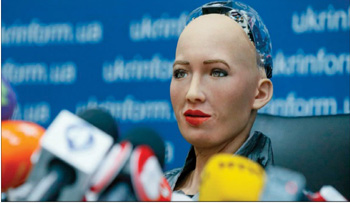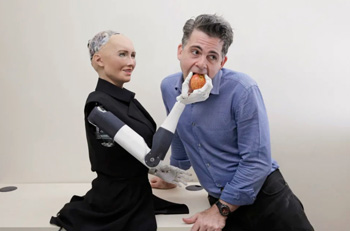Transhumanism & Artificial Intelligence
 |
 |
 |
 |
 |
 |
 |
‘Artificial Intelligence’ vs. Human Intelligence?
Note: The article we reproduce on this page was published today in L'Osservatore Romano (Weekly English edition). It expresses the Vatican's position of support for the creation of humanoids or androids – robots made with human features – that modern technology is rapidly developing. Although the author is very clear in distinguishing between human and artificial intelligence – and this helps us to understand the whole topic of the humanoids – it shows approval for their production. We do not agree with such support. - The EditorSophia is perhaps the best-known artificial intelligence platform in the world. Its advanced machine learning system, “incorporated” and supported by a humanoid robot with the apparent features of the actress Audrey Hepburn, is able to interact cognitively and even emotionally with us. Numerous trials have been done over the years, as well as television interviews and conferences at the United Nations. The parliament of Saudi Arabia has even conferred honorary citizenship upon “her.” (1)

Sophia the Robot
The important contributions of evolutionary psychologist Howard Gardner to the topic of multiple intelligence, together with the neuroscientific developments that integrate the interdependent role of other organ systems and apparatuses in the coordinative centrality of our nervous system (the so-called Embodied Neurology), have ensured that developments in artificial intelligence, rather than focusing on the possibility of producing robotic entities endowed with human-like intelligence, are helping us to distinguish in greater depth the status of human intelligence, its peculiarities and, consequently, the hiatus that exists between the two, which distinguishes us as a biological species and what we produce as artifacts.
The problem of imitating or reproducing human thought has marked the history of humanity. We have always tried to compensate our bodily deficiencies with the construction of artifacts. The technique became, with the advent of the experimental method of the 17th century, technology. From classical Antiquity to the Middle Ages, from Modernity to Post-Modernity, there have been various ways of resolving the imitation problem.

Sophia the Robot giving Hanson Robotics founder David Hanson an apple, possibly alluding to Eve giving Adam the forbidden fruit
The idea that human intelligence is the result of elementary calculations capable of generating even very complex processes has been diluted and dampened bit by bit over time so that today’s goal of AI is more limited, humble and, therefore, real: the construction of machines capable of executing calculations useful for specific tasks such as, for example, the visual recognition of objects; the auditory recognition of sounds; the recognition of texts; the management and control of very complex processes such as those in airplanes, spacecraft or space probes; and the performance of actions such as those of robots, drones or similar devices.
Anticipating by 15 years the famous thesis of intentionality by the American philosopher John Rogers Searle (1932-), the Italian philosopher of science Evandro Agazzi (1934-) made an in-depth analysis and critique of different approaches to this theme, in particular regarding operationalism and functionalism, outlining an articulated conception of a realist mold. (2) It cannot be said, as often happens, that computers or modern humanoid robots like Sophia have thoughts or feelings similar to those of human beings because they are not endowed with intentionality.
Certainly the evolution of digital and artificial intelligence is patent and represents a good if placed at the service of the integral development of all human beings [our emphasis]; certainly today complex machines are being built that are capable of achieving performances very similar to those achieved by human reasoning, or intentional behaviors in many sectors of production, conception, the production of goods and services. Certainly, however, this similarity is confined to the ability to perform certain operations, while the difference that remains – and that will remain – is the ability to give meaning to these operations and their results, and to intentionally set goals. This is what makes our intelligence radically different from artificial intelligence.
He first published this article in L’Osservatore Romano,
on February 11, 2022, Weekly Edition in English, p. 6.
- To find out more about “Sophia”: https://www.hansonrobotics.com/sophia/
- Read, for example, the two essays “Some observations on the problem of artificial intelligence” (1967) and “Operationality and intentionality: the missing link of artificial intelligence” (1981).

Posted February 11, 2022
______________________
______________________
 Volume I |
 Volume II |
 Volume III |
 Volume IV |
 Volume V |
 Volume VI |
 Volume VII |
 Volume VIII |
 Volume IX |
 Volume X |
 Volume XI |
 Special Edition |


